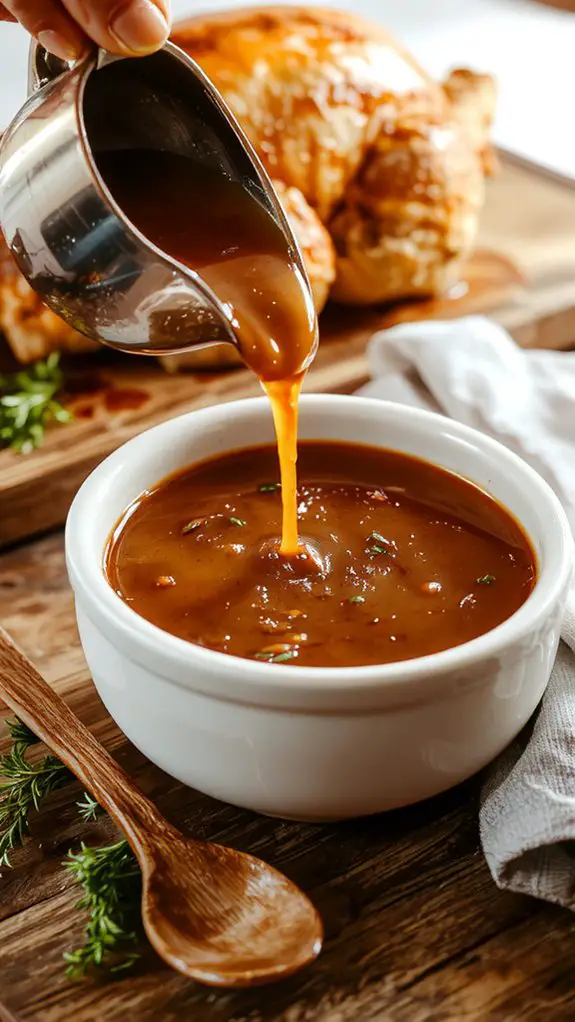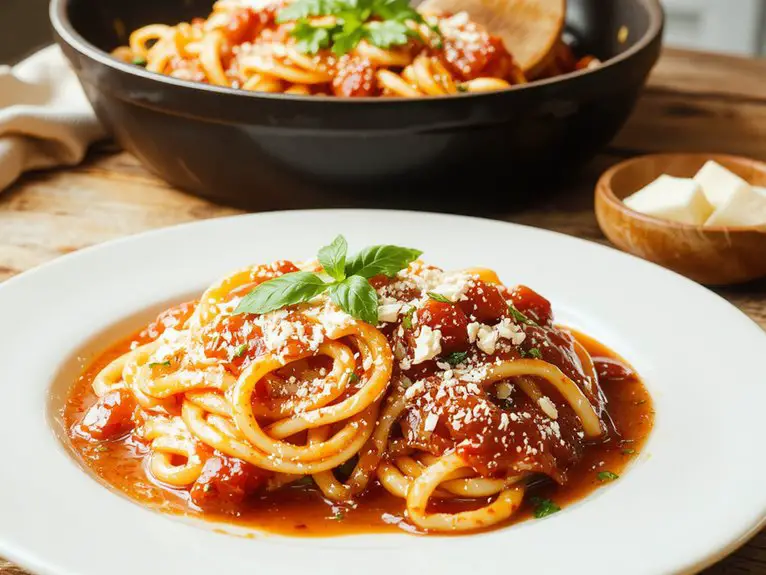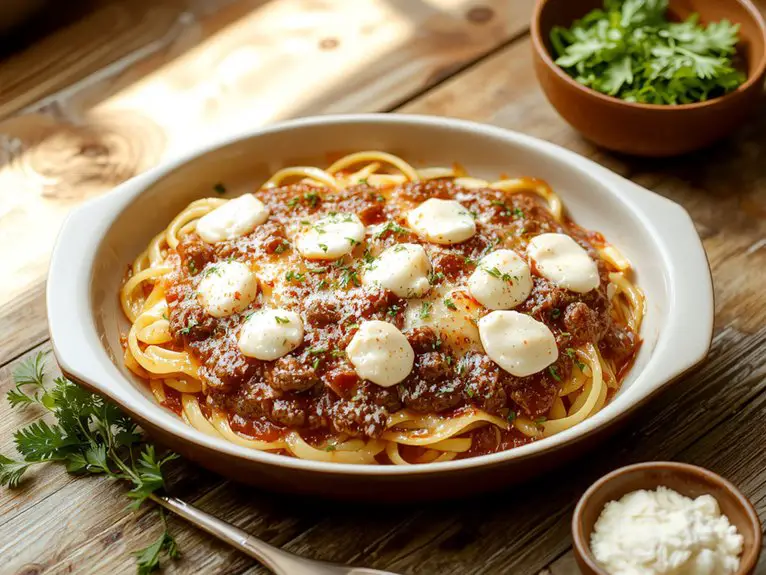Recipe
I can say with absolute certainty that this homemade gravy will change the game for your meals forever. Forget the jarred stuff—this recipe is all about rich, savory flavor and silky smooth texture that’ll have everyone asking for seconds.
The secret? Perfectly browned butter, a splash of quality stock, and a pinch of fresh herbs that bring it all together. Whether you’re drizzling it over mashed potatoes, smothering a roast, or pairing it with biscuits, this gravy is the comforting, soul-warming touch your table needs.
It’s easier to make than you think, and the aroma alone will have your kitchen smelling like a holiday feast. Trust me, once you try this, you’ll never go back to store-bought.
Ingredients
Great gravy starts with the right ingredients—each one building layers of flavor that turn pan drippings into liquid gold. Here’s what you’ll need, plus insider tricks to make it unforgettable:
- Pan drippings: The soul of your gravy. Roast meat (turkey, chicken, or beef) drippings add depth—don’t even think about skipping these. *No drippings?* Sauté meat scraps in butter for a cheat.
- Butter or fat: 2-3 tablespoons to build your roux. Butter adds richness, but bacon fat or duck fat? Next-level.
- All-purpose flour: The thickening hero. *Pro tip:* Cook it with fat until golden (1-2 minutes) to avoid a pasty taste.
- Broth or stock: 2-3 cups, warmed. Homestock is ideal, but boxed works—just opt for low-sodium to control saltiness. *Vegetable broth* for a meat-free version.
- Salt & pepper: Season at the end to avoid over-salting as gravy reduces. Freshly cracked black pepper is non-negotiable.
- Worcestershire sauce (optional): A dash adds umami. *No Worcestershire?* Soy sauce or balsamic vinegar (sparingly) can sub.
- Fresh herbs (optional): Thyme or rosemary sprigs simmered in for aroma. Remove before serving.
*Little win:* Deglaze the pan with a splash of white wine or sherry before adding broth—it lifts all the caramelized bits into your gravy.
How to Make the Best Classic Turkey Gravy Recipe

– Collect Pan Drippings: Once your turkey is out of the oven, carefully transfer it to a cutting board or platter. Pour the pan drippings into a heatproof measuring cup or bowl, making sure you scrape up all the flavorful browned bits from the bottom of the pan.
*Pro Tip:* Let the drippings settle for a minute—this separates the fat from the juices, making it easier to skim later.
– Skim the Fat: Use a spoon or fat separator to skim off the fat from the drippings. Reserve about ¼ cup of fat for making the roux—this adds richness and depth of flavor.
*Watch Out:* Don’t discard all the fat! It’s essential for creating the perfect gravy texture.
– Make the Roux: In a saucepan, heat the reserved fat over medium heat. Gradually whisk in an equal amount of all-purpose flour (start with ¼ cup). Cook the mixture, stirring constantly, for 2–3 minutes until it turns a light golden brown.
*Why It Matters:* Cooking the flour eliminates its raw taste and guarantees a smooth, lump-free gravy.
– Add Pan Juices: Slowly pour the skimmed pan juices into the roux, whisking continuously to avoid lumps. If you don’t have enough pan juices, supplement with turkey or chicken broth.
*Time-Saving Trick:* Warm the broth before adding it to the roux—this helps thicken the gravy more evenly.
– Simmer and Thicken: Bring the mixture to a gentle simmer, stirring frequently. Let it cook for 5–10 minutes until it reaches your desired consistency. If it’s too thick, add more broth a splash at a time.
*Visual Cue:* The gravy should coat the back of a spoon but still flow smoothly.
– Season to Taste: Taste the gravy and season with salt, pepper, and any additional herbs or spices you like (e.g., thyme, rosemary, or a splash of soy sauce for umami).
*Flexibility:* Adjust seasoning gradually—you can always add more, but you can’t take it away!
– Strain for Smoothness: For an extra-silky texture, strain the gravy through a fine-mesh sieve into a serving pitcher or bowl. This removes any lumps or stray bits.
*Pro Tip:* If you prefer a rustic gravy, skip this step for a more textured result.
– Serve Warm: Keep the gravy warm in a saucepan or gravy boat until ready to serve. Give it a quick whisk before pouring.
*Watch Out:* Gravy thickens as it cools, so adjust consistency with a little broth if needed before serving.
Nutrition
Homemade gravy is a versatile sauce that complements a variety of dishes. Here’s the nutritional breakdown per serving (1/4 cup).
| Calories | Total Fat (g) | Saturated Fat (g) | Cholesterol (mg) | Sodium (mg) | Total Carbohydrates (g) | Protein (g) |
|---|---|---|---|---|---|---|
| 25 | 1.5 | 0.5 | 3 | 200 | 2 | 1 |
Chef Tips
When making homemade gravy, I always start by ensuring my roux is smooth and cooked to the right shade—neither too pale nor too dark. I whisk constantly to avoid lumps and deglaze the pan with stock for extra flavor.
A splash of wine adds depth, but don’t overdo it. Season gradually and taste as you go.
Strain for silky texture, and keep it warm until serving.
Frequently Asked Questions
Can I Freeze Homemade Gravy?
Yes, I can freeze homemade gravy. I store it in airtight containers or freezer bags, leaving some space for expansion. When I need it, I thaw it in the fridge overnight and reheat it on the stove.
How Long Does Homemade Gravy Last in the Fridge?
I’d say homemade gravy lasts about 3-4 days in the fridge if I store it in an airtight container. I always check for off smells or mold before using it, just to be safe.
Can I Make Gravy Without Turkey Drippings?
Yes, I can make gravy without turkey drippings. I’ll use butter or oil as a fat base, mix in flour to make a roux, and add broth for flavor. It’s easy and still tastes rich and delicious.
What’s the Best Thickener for Gravy?
I’d recommend using a roux made from equal parts butter and flour as the best thickener for gravy. It’s smooth, easy to control, and doesn’t leave a floury taste if you cook it properly.
Can I Substitute Butter for Drippings in Gravy?
I’d say you can substitute butter for drippings—it’ll still taste rich. Just melt it first and whisk it with flour like you would with drippings. The flavor won’t be as deep, but it’ll work.










